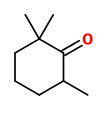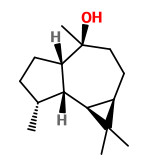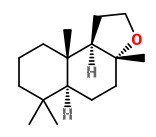Cistus ladanifer L. - Cistaceae - common gum cistus, gum rockrose, Lack-Zistrose
Native fragrant shrub of the Mediterraneaen and North Africa; cultivated in France, Spain and Madagascar.
„Evergreen shrub of loose, open habit with very sticky, narrow, aromatic leaves, dark green above, grey beneath. Flowers to 10cm in width, white with a deep red blotch at the base of each petal“ http://www.rhs.org.uk/plants/details?plantid=2453
„It is a popular ornamental plant, grown for its strongly resin-scented foliage and conspicuous flowers. Its leaves yield a fragrant oleoresin known as labdanum, used in perfumes, especially as a fixative.“
http://en.wikipedia.org/wiki/Cistus_ladanifer
Labdanum resin is the sticky exudate of the glandular hairs of C.labdaniferum. Maceration with alcohol yield 1-2% of labdanum oil.
Cistus oil is the essential oil produced by solvent extraction or steam distillation of the twigs with leaves.
Main components of hydrodistilled (leaves+twigs) Cistus oil were tricyclene+α-thujene (1.2%), α-pinene (40.8%), camphene (6.0%), para cymene (1.9%), limonene+β-phellandrene (1.9%), eucalyptol (2.9%), E-β-ocimene (1.1%), γ-terpinene (1.0%), terpinolene (1.8%), ledene (1.6%), ledol (2.6%), and viridiflorol (1.0%). Minor components were e.g. benzaldehyde (0.9%), linalool (0.5%), and ambrox (0.16%).
[Moyler, D. A., R. A. Clery, and K. A. D. Swift. „Flavours and Fragrances.“ Special Publications No. 214 (1997): 96-115]
Commercial labdanum oil contained more than 300 constituents. Of the 186 compounds identified (95% of the oil), 154 were neutral, and 32 acidic. Typical for labdanum oil were oxidized derivatives of C15-C20 ring systems (aromadendrane, cadinane, and labdane).
Main constituents of the oil were ledene (9.3%), dihydrocinnamic acid (6.5%), labd-7-enoic acid (6.3%), myrtenic acid (6.0%), labd-8(17)-enoic acid (5.1%), palmitic acid (5.1%), viridiflorol (4.3%), cubeban‐11‐ol (4.1%), labd-8-enoic acid (4.0%), decanoic acid (3.8%), octanoic acid (3.7%), myristic acid (2.7%), lauric acid (2.5%), borneol (2.0%), copaborneol (1.8%), bornyl acetate (1.7%), eugenol (1.6%), allo‐aromadendrene (1.5%), 1,5‐cis‐aromadendr‐9‐ene (1.4%), 1,2‐dehydroviridiflorol (1.4%), geranic acid (1.4%), ambrox (1.4%), 2,2,6-trimethyl cyclohexanone (1.3%), ledol (1.3%), and palustrol (1.2%).
Further interesting components were 6-oxo-iso ambrox (0.1%), α-ambrinol (0.2%), carvacrol (0.8%), dehydrocarvacrol (0.2%), cuminaldehyde (0.1%), decanal (0.2%), β-ionone (0.2%), massoia lactone (0.1%), nonanal (0.1%), trans-rose oxide (0.1%), cis-rose oxide (0.2%), α-terpineol (0.5%), thymol (0.2%), 2,6,6-trimethyl cyclohex-2-enone (0.3%), tuberolactone (0.1%), undecanal (0.2%), undecanoic acid (0.3%), vitispiran A (0.2%), vitispiran B (0.1%) e.g.
[Weyerstahl, Peter, et al. „Constituents of commercial Labdanum oil.“ Flavour and Fragrance Journal 13.5 (1998): 295-318]
see also http://www.thegoodscentscompany.com/gca/gc1026971.html
Among the volatile components of Cistus ladanifer leaves, the norisoprenoid 2,6,6-trimethylcyclohex-2-enone was identified as the compound mainly responsible for the leaf odor.
[Volatile components of Cistus ladanifer leaves. Ramalho, Paula S., et al., Flavour and fragrance journal Vol.14 (5), 1999, 300-302]
The essential oils of the two varieties C.ladanifer var.maculatus (with red marks on the white corolla) and C. ladanifer var.albiflorus (without red marks) contained the same major components.
„Essential oils of the three populations of Cistus ladanifer var. maculatus have significantly higher concentrations in α-pinene, β-pinene, γ-terpinene, verbenone than the oils from the three populations of Cistus ladanifer var. albiflorus. The latter oils have significantly lower concentrations of benzaldehyde, p-cymen-8-ol, ledol and viridiflorol than the oils of Cistus ladanifer var. maculatus. These differences can not be attributed to differences in environmental conditions…“
[Robles, Christine, et al. „Comparison of essential oil composition of two varieties of Cistus ladanifer.“ Biochemical Systematics and Ecology 31.3 (2003): 339-343]
„Labdanum oil is a mixture of ca. 250 compounds… Only ten compounds, i.e., (-)α-pinene, (+)-camphene, pinocarveol, bornyl acetate, borneol, 2,2,6-trimethylcyclohexanone, (Z)-ocimenone, (-)-allo-aromadendrene/(+)-ledene, (+)-ledol, and viridiflorol, occur in concentrations above 1%, however, these do not represent the complex odor profile of the oil. The odor character of labdanum oil is on the contrary determined by a large number of oxygenated trace compounds such as (-)-ambrox, 6-oxoisoambrox and a decahydronaphthalenol, which are responsible for the distinct ambery character… The smoky-leathery notes and the animalic undertones are caused by a complex of 25 phenols (1.5%)… The character-impact compound of oakmoss, methyl beta-orcinolcarboxylate, is responsible for the powdery, moss-like undertones… Another constituent, 2-methyloctanoic acid, has a strong labdanoic odor on its own, (and) 3,4,4-trimethylcyclopentane-1,2-dione… has a strong celery aroma.“
[S.Escher, Firmenich SA, unpublished results; cited by Roman Kaiser, Meaningful Scents around the World, Roman Kaiser, Zürich 2006, 313ff]
see also [Scent and Chemistry, Günther Ohloff, Wilhelm Pickenhagen, Philip Kraft, Wiley-VCH, 2012, 312-317]
The most common compounds found in cistus essential oil are: α-pinene (0-56%), camphene (0-10%), limonene (0-2%), p-cymene (0-4%), 2,2,6-trimethylcyclohexanone (0-11%), α-campholenic aldehyde (0-3%), bornyl acetate (2-3%), terpinen-4-ol (0-3%), allo-aromadendrene (0-1%), trans-pinocarveol (0-7%), borneol (0-3%), myrtenol (0-2%), ledol (0-13%), viridiflorol (0-21%). The odor intensive ambrox is present at 0.8%.
[Characterization of the Portuguese-grown Cistus ladanifer essential oil. Gomes, Paula B., Vera G. Mata, and A. E. Rodrigues. Journal of Essential Oil Research, Vol.17 (2), 2005, 160-165] http://teresacasimiro.com.sapo.pt/Bibliographic_References/21.pdf
[Simultaneous distillation–extraction of high-value volatile compounds from Cistus ladanifer L., Teixeira, Salomé, et al., Analytica chimica acta 584.2, 2007, 439-446]
http://repositorio-aberto.up.pt/bitstream/10216/67702/2/12532.pdf
Hydrodistillation of the fresh leaves with small branches of Cistus ladanifer L. var. albiflorus lead to an oil (0.3-0.4% fresh weight) with viridiflorol (19.4%), bornyl acetate (16.5%), and camphene (12.1%) as main components. Other main constituents were α-pinene (5.0%), 2,2,6-trimethylcyclohexanone (3.6%), borneol (3.5%), terpinen-4-ol (4.1%), and ledol (8.0%) e.g.
The volatile portion (3.1%) of the resinoid (2.9% of the dried material) contained free acids (27.8%, like phenylpropionic acid 1.1%, cinnamic acid 1.2% e.g.), phenols (23.8%), and neutral compounds (39.4%) with labd-14-ene-16,18-diol (7.7%) and labd-14-ene-8,13-diol (sclareol, 5.2%) as main identified compounds.
[Greche, Hassane, et al. „The volatiles of the leaf oil of Cistus ladanifer L. var. albiflorus and labdanum extracts of moroccan origin and their antimicrobial activities.“ Journal of Essential Oil Research 21.2 (2009): 166-173]
„Labdanum is a compley mixture of over 250 ingredients and none of the 10 components that occur in >1.0% amounts does contribute really to the typical smell as detailed in 'Scent and Chemistry'. We mentioned already the fruity 'Egoïste' and the incense part of labdanum. That is backed up by the floral-rosy part around Vitispirane A, rose oxide, dehydrogeraniol, 9-oxodamascone, 2-phenylethanol and derivatives. As yes, labdanum or ciste is also known as 'gum rockrose'. This rosy side is forming a nice accord with the ambergris block of labdanum around (–)-ambrox, 6-oxo-isoambrox, and (2R,4aS,8aR)-2,5,5,8a-tetramethyldecahydro-naphthalen-2-ol. This is underscored by a hay-like coumarinic part around 8(9)-dehydrocarvacrol and lactones that also can convey a plumy message while being not plumy itself. There are mossy and resinous blocks, but key is as well a leathery animalic block of 25 phenols with 3,5-dimethylsalicylic aldehyde, 6-methyl-2-hydroxy-acetophenone and o-hydroxy cuminal being most important… So labdanum is a perfume in itself already…“
[P.Kraft, fb post 2016] https://www.facebook.com/ScentChemistry/posts/after-we-saw-a-lot-of-solimolecule-fragrances-around-a-single-synthetic-ingredie/1553159284711080/
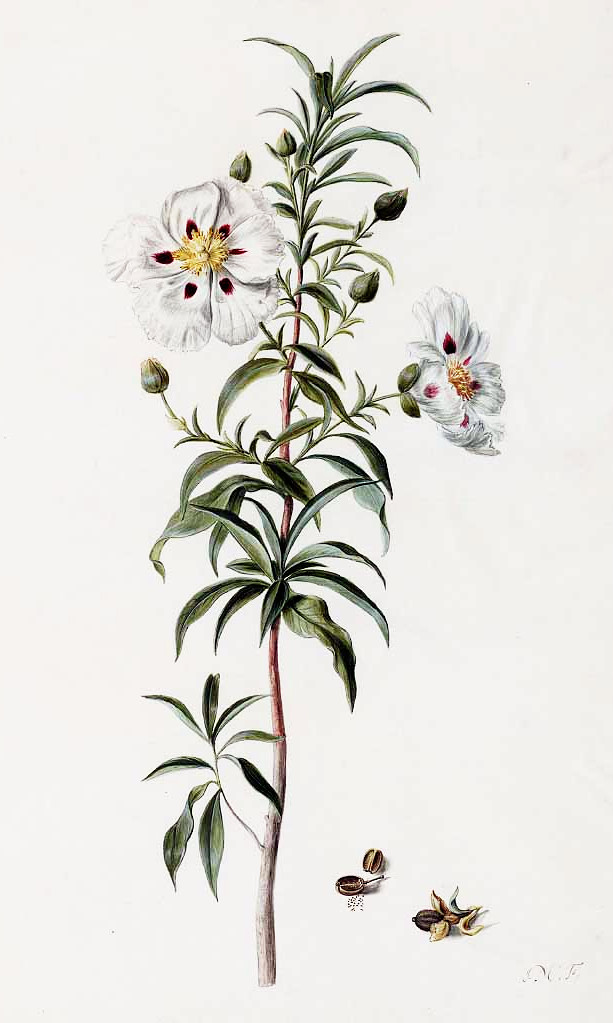
Moninckx,J., Moninckx atlas, vol.2, t.41 (1682-1709)
http://plantgenera.org/species.php?id_species=248956
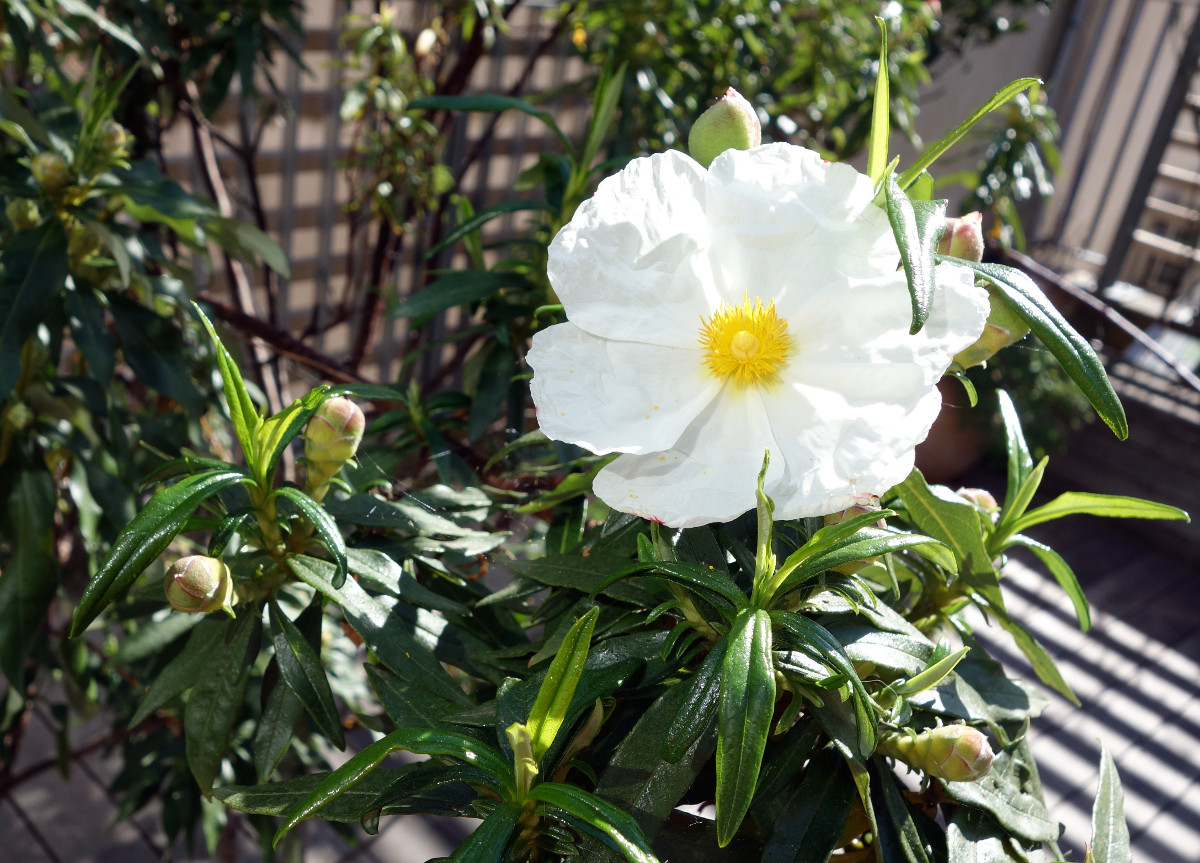
Cistus ladanifer var.albiflorus, CC BY-SA 3.0, Author: Andreas Kraska

